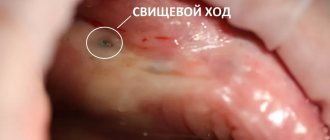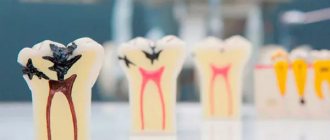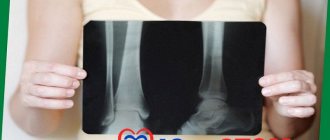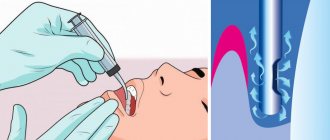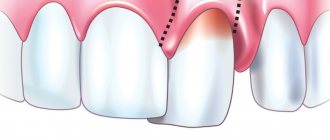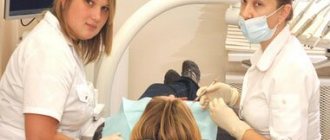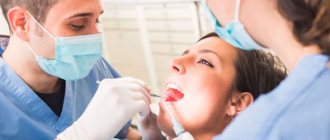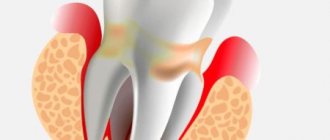If you are concerned about inflammation of the gums in the area of the mouth where the wisdom tooth is located, it is likely that you are developing pericoronitis
. The essence of this disease is that the gums that surround the tooth become inflamed. This situation usually occurs when eruption is difficult or incomplete. In practice, this disease most often occurs when the lower wisdom teeth erupt.
The pain may increase with chewing, pressing on the tooth, swallowing, or contact with hot, sour or cold foods. A feeling of discomfort may occur when opening the mouth.
Visually pericoronitis
characterized by reddened and swollen gums located near the erupting tooth, while pus may be released from the gums, and the patient’s temperature may rise to 38 degrees.
Quite often, the eruption of wisdom teeth is accompanied by complications in people, the cause of which may be insufficient space for its growth or incorrect position of the tooth in the jaw.
If a wisdom tooth does not fully erupt, a kind of hood forms over it, which is a gum that partially covers the tooth. A certain space appears between the tooth and the gum, where there are favorable conditions for the accumulation of microorganisms and food debris, which ultimately leads to the development of caries or other serious diseases.
Pericoranitis is treated surgically in a dental clinic. The gum that hangs over the wisdom tooth is incised, and the resulting wound is treated with a strong antiseptic solution. If the dentist believes that such dental treatment will not bring relief to the patient, then a decision is made to remove the wisdom tooth.
Read also
The gum under the tooth hurts
Gum inflammation
Inflamed and bleeding gums
If the pain suddenly overtakes a person, and he does not have the opportunity to visit the dentist at the moment, you can reduce the pain by following these recommendations:
- To avoid aggravating gum inflammation, do not apply warm compresses to it;
- to relieve the pain caused by a wisdom tooth, take 1-2 tablets of analgin, paracetamol or tempalgin;
- It is recommended to rinse your mouth with a weak solution of soda at room temperature;
- do not take anti-inflammatory drugs and antibiotics without a doctor’s recommendation;
- At the first symptoms of pericoronoritis, contact your dentist immediately.
It should be noted that all of the above methods only temporarily reduce gum inflammation caused by an erupting wisdom tooth, and in order to completely eliminate the causes of pain, the help of a professional dentist is necessary.
What is a tooth abscess
An abscess in dentistry is an inflammatory process accompanied by the formation of a cavity with pus near a segment or its root. The abscess on the root of the tooth is surrounded by a dense connective tissue capsule, separating it from healthy tissue. Pyogenic bacteria penetrate into the unit through chips, cracks, and carious cavities.
During their life, microbes produce toxins that irritate the pulpal nerve receptors, which causes pain. In addition, toxic products of pathogenic flora increase vascular permeability, resulting in soft tissue swelling.
There are three main types of abscess:
- Periapical - pus accumulates at the root of the tooth (near its apex). A hilar abscess is formed due to an infectious lesion of the pulp. The etiological factor is untreated caries or periodontitis. The progressive inflammatory process spreads to the periosteum and surrounding soft tissue with the formation of a fistula and purulent lump on the gum.
- Periodontal - the focus is located inside the periodontal pockets. The cause is periodontitis. The pulp remains intact, and the infection is localized between the gum and the alveolar ridge.
- Desnevoy. Gum abscess is a purulent formation in the area of the gingival papillae between the segments.
Eruption of wisdom teeth: inflammation and consequences
The figure eight on the lower jaw begins to create problems from the moment of eruption, when the crown rests closely on the adjacent tooth or is tightly covered with a hood. When the hood becomes inflamed, favorable conditions are created under it for the proliferation of pathological microorganisms, and the gums are involved in the process. This manifests itself as pain during chewing or when accidentally biting the mucous membrane. It happens that a wisdom tooth partially erupts, and one or more tubercles rest against the hood, injuring it. In this case, the inflammation of the gums near the wisdom tooth will have to be treated by removing the hood or the tooth itself. If the figure eight is healthy and does not interfere with the adjacent tooth during eruption, then the dentist makes an incision in the hood so that the tooth can erupt calmly.
How to treat inflammation of the hood and gums near the wisdom tooth at home? To do this, you will need to regularly rinse, rinse the mouth with antiseptic solutions and take analgesic and anti-inflammatory drugs for pain relief: Nimesil, Ketanov, Ibuprofen. If the hood is inflamed, you can rinse your mouth with weak solutions of the antiseptic Chlorhexidine, soda and saline solutions.
WHY DOES PUS APPEAR IN THE Socket AFTER TOOTH EXTRACTION
This complication is a sign of infection of the socket, which, in turn, can occur for the following reasons:
- violation of the doctor’s recommendations for oral care (for example, removing a blood clot on your own);
- use of non-sterile instruments by the dentist;
- violation of tooth extraction technique;
- violation of the integrity of the walls of the maxillary sinus during removal;
- general decrease in immunity in the patient;
- the presence of a foreign body in the socket (for example, a fragment of a tooth or part of a cotton swab).
The risk of pus developing after the removal of a wisdom tooth is much higher than after the removal of any other tooth. This is due to the inaccessibility of the third molars, as well as additional difficulties during their extraction (for example, due to curvature of the coronal part or retention).
Gum suppuration is manifested by the following symptoms:
- pain;
- swelling and redness that do not go away, but on the contrary, intensify for three or more days;
- discharge from the socket;
- bad breath;
- general deterioration in health (fever, etc.).
Pericoronitis: how to treat gum inflammation at home?
Pericoronitis is accompanied by very unpleasant sensations. This disease occurs just during the eruption of a wisdom tooth, and you need to know how to relieve inflammation of the figure eight, especially in the lower jaw.
Surgical removal of the hood is only half of the treatment; the crown continues to erupt, so you need to prevent inflammation at home. It is important to give the figure eight space to erupt in a timely manner in order to eliminate infection and all its consequences. If your figure eight is erupting and this is accompanied by unpleasant symptoms, it is better not to delay and contact Leaderst dentists. At a free consultation, you will receive information that will protect you from teething problems, help you avoid tooth extraction and maintain oral health.
What to do and how to treat the gums when the figure eight erupts on the upper and lower jaws?
- Clean the oral cavity thoroughly, despite slight discomfort, since the largest number of microorganisms accumulate in the area of the erupting figure eight, which can cause pericoronitis;
- Use additional hygiene products: irrigator, rinses are very important for the prevention of gum disease not only during the teething of the figure eight, but throughout life;
- The eruption itself, even without inflammation, causes discomfort, and to relieve pain in the area of the third molar, you can take drugs such as Nimesil, Ketanov, Nise, Ibuprofen, they not only relieve pain, but also fight inflammation in the tooth area;
- Under no circumstances should you apply hot compresses to your cheek, and especially to your tooth; only cold compresses can relieve pain for a while;
- It is necessary to treat the hood not only locally, but also by following general principles, that is, eat right, avoid hypothermia, since a decrease in the protective mechanism provokes an intensification of the clinical picture, and then it will be more difficult to remove the infection and relieve pain;
- You also need to treat inflammation with folk remedies: rinse your mouth with a decoction of chamomile, sage, oak bark, and take baths.
Causes
The main causes of tooth abscess can be considered:
- various untreated oral diseases (for example, cyst, pulpitis, caries and others);
- injuries to the jaw or mouth that led to the breaking off or fracture of a tooth;
- infection (brought in by blood);
- damage to the skin around the mouth or mucous membranes;
- the appearance of boils (on the skin) near the jaw;
- the appearance of infection due to drift during injections;
- poor oral hygiene.
Any tooth in the oral cavity is susceptible to an abscess, but those teeth that are involved in chewing food, as well as wisdom teeth, are most susceptible. An abscess is often accompanied by infections in the respiratory tract.
Symptoms
Experts call the following symptoms that accompany an abscess:
- acute pain (can be aching or throbbing);
- toothache when chewing;
- greater sensitivity of the tooth when exposed to temperature;
- bitter taste in the mouth;
- change in appetite;
- general malaise;
- discomfort accompanying a person;
- enlarged cervical lymph nodes;
- elevated temperature;
- the gums become red;
- the appearance of open ulcers with pus on the gums;
- swelling of the face near the jaw.
After the tooth root has died, the symptoms (not all) may disappear, but this is a temporary effect, since the infection will still develop.
It is possible that the abscess may open on its own. This means the transition of an acute to a chronic abscess, after which the symptoms subside. Chronic abscess is fraught with other exacerbations with complications.
Complications
Chronic abscess is the most harmless complication. Occurs with varying frequency. Chronic abscess is difficult to treat and can lead to complications.
A purulent tooth abscess is dangerous due to complications; if left untreated, the following may occur:
- Phlegmon is a tumor that does not have clear boundaries. Cellulitis is dangerous because it can be fatal. Requires surgical treatment.
- Sepsis is blood poisoning. Against the background of an infectious process, septic shock may develop in the patient’s body.
- A cyst is a benign tumor that tends to grow. It is useless to treat it with medication; surgical intervention is required.
- Meningitis is an inflammation of the membranes of the brain that affects a person’s mental state, leading to blindness, deafness and other serious consequences.
- Brain abscess - occurs because pathogens enter the brain, causing inflammation. The complication is difficult to treat and can lead to the death of the patient.
High fever and pain due to inflammation of the hood
The eruption of the figure eight may be accompanied by general symptoms such as high fever, weakness, nausea, and lack of appetite. Such signs are associated with infection, so you need to consult a doctor, since treating intoxication at home is unsafe. First aid will be to drink plenty of fluids and take diuretics. A high temperature during the eruption of the figure eight can last for several days, so the doctor will individually prescribe antipyretics and tell you how to relieve pain and treat inflammation in the gum area in order to avoid unpleasant symptoms in the future. It is easy to remove inflammation and relieve pain at home, but this will only mask a serious disruption in the process of teething, so it is important to know the dangerous symptoms that require immediate consultation with a dentist.
When should you see a dentist if your figure eight is teething and your hood is inflamed?
- It is not possible to treat inflammation at home, and the symptoms only get worse;
- The gums near the figure eight are swollen, there is throbbing pain;
- It hurts to chew and swallow, the symptoms make it difficult to sleep at night;
- It is not possible to relieve pain in the gum area with analgesics;
- The gums around the figure eight swell, purulent exudate accumulates;
- The figure eight erupts incorrectly and puts pressure on the adjacent tooth.
What such phenomena can lead to without treatment, you will be told at the Leaderstom clinic, where consultation is not only free, but also saves the health of the eight and the entire dentition.
Tooth abscess: what is it - symptoms and treatment
A dental abscess is an acute infectious pathology characterized by a clearly limited accumulation of pus in the root area. The purulent process is often a dangerous complication of periodontitis, periostitis, and other dental diseases. The lack of timely treatment threatens with adverse consequences not only for the affected segment, but also for the entire body. In Moscow, dental services are provided by the Center for Aesthetic Dentistry near the Otradnoye metro station. Our doctors will quickly and efficiently help eliminate any problem with sore teeth and gums.
Prevention
Thorough oral hygiene, brushing your teeth 2 times a day, regular visits to the dentist and treatment of any “local” diseases will help avoid the development of an inflammatory process during the eruption of third molars. In addition, for the overall health of the body and minimizing the risk of developing any dental diseases, it is recommended to take regular courses of multivitamin complexes (pay special attention to calcium, potassium, magnesium, ascorbic acid), give up bad habits, follow a daily routine and, if possible, avoid stress.
So, discomfort in the area of growing “eights” may be a variant of the norm - this is how soft tissues “respond” to microtraumas that occur during teething. If pain and swelling persist for a long time, are accompanied by weakness, hyperthermia, swelling of the gums (cheeks), and, in addition, a purulent sac appears in the affected area, we are talking about a pathological inflammatory process that requires immediate treatment. In the absence of timely medical intervention, such pathological changes can result in phlegmon, abscess, periostitis and other complications.
